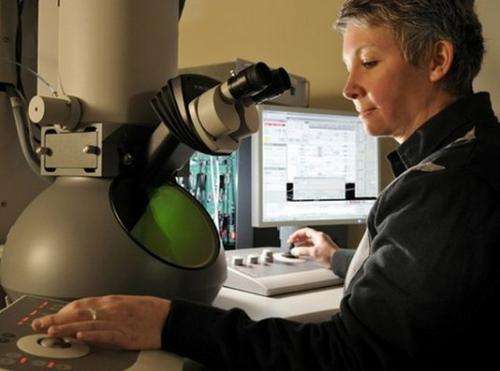Deborah Kelly.
(Phys.org) —The macroscopic effects of certain nanoparticles on human health have long been clear to the naked eye. What scientists have lacked is the ability to see the detailed movements of individual particles that give rise to those effects.
In a recently published study, scientists at the Virginia Tech Carilion Research Institute invented a technique for imaging nanoparticle dynamics with atomic resolution as these dynamics occur in a liquid environment. The results will allow, for the first time, the imaging of nanoscale processes, such as the engulfment of nanoparticles into cells.
"We were stunned to see the large-ranged mobility in such small objects," said Deborah Kelly, an assistant professor at the Virginia Tech Carilion Research Institute. "We now have a system to watch the behaviors of therapeutic nanoparticles at atomic resolution."
Nanoparticles are made of many materials and come in different shapes and sizes. In the new study, Kelly and her colleagues chose to make rod-shaped gold nanoparticles the stars of their new molecular movies. These nanoparticles, roughly the size of a virus, are used to treat various forms of cancer. Once injected, they accumulate in solid tumors. Infrared radiation is then used to heat them and destroy nearby cancerous cells.
To take an up-close look at the gold nanoparticles in action, the researchers made a vacuum-tight microfluidic chamber by pressing two silicon-nitride semiconductor chips together with a 150-nanometer spacer in between. The microchips contained transparent windows so the beam from a transmission electron microscope could pass through to create an atomic-scale image.
Using the new technique, the scientists created two types of visualizations. The first included pictures of individual nanoparticles' atomic structures at 100,000-times magnification – the highest resolution images ever taken of nanoparticles in a liquid environment.
The second visualization was a movie captured at 23,000-times magnification that revealed the movements of a group of nanoparticles reacting to an electron beam, which mimics the effects of the infrared radiation used in cancer therapies.
For the first time, scientists are able to image nanoparticles in action in a liquid environment.
In the movie, the gold nanoparticles can be seen surfing nanoscale tidal waves.
"The nanoparticles behaved like grains of sand being concentrated on a beach by crashing waves," said Kelly. "We think this behavior may be related to why the nanoparticles become concentrated in tumors. Our next experiment will be to insert a cancer cell to study the nanoparticles' therapeutic effects on tumors."
The team is also testing the resolution of the microfluidic system with other reagents and materials, bringing researchers one step closer to viewing live biological mechanisms in action at the highest levels of resolution possible.
The study appeared in Chemical Communications in the article "Visualizing Nanoparticle Mobility in Liquid at Atomic Resolution."
Journal information: Chemical Communications
Provided by Virginia Tech























